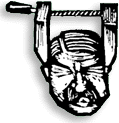
What
do you like about managing cash flow with Clients & Profits?
A recent survey asked: What do you like about managing cash flow with
Clients & Profits? Their answers explain why so many shops use it
as their one, and only, agency software.
CASH
FLOW Q&A
When is the right time to write off a client's unpaid invoice? Get answers
to this and other important questions, along with some guaranteed
great ideas.
CLIENT
INVOICE AGING REPORT
How to know what's outstanding, pay what's due, and plan
for the future
A detailed Report showing the individual client invoices whose grand
totals appear in the Cash Flash Client Balances.

Printer-friendly
Click the link below to download the complete Acrobat-based version of
the Trafficking newsletter:
 Cash
Flow (352k) Cash
Flow (352k) |
|
By Judith Hector
W hen the dot-com bubble burst in mid-2000, agencies took
it in the shorts. Big-time. But step back from the write-offs
and red ink and look at the underlying cash flow lesson. The
main reason, maybe the only reason, dot-coms tanked is bad cash
flow management. Not to vilify them -- some dot-coms are indeed
profitable and their collective growth fueled a terrific economic
expansion -- but overall, the two-rule lesson is this: get your
income as soon as possible and make sure there is cash to pay
the bills when they are due.
"Five years ago times were good so I managed my revenue by watching sales to
make sure income was coming in steadily. Now my business paradigm has changed," says
Roxanne Cowan, controller for Rutherford Bolen Group in Campbell, CA. "Every
morning I check my bank balance so I can release checks."
Planning costs and monitoring your revenue stream is the foundation of
good cash flow management. Clients & Profits has many built-in features
to get you started, from budgets to automatic e-mail to client and financial
reports as well as invoice choices for every scenario. The first step
is to develop a strategy to manage cash. This includes establishing budgets,
invoicing and collections processes, payment strategies, and investment
options for idle cash (because, of course, cash should never be idle!).
Sloppy budgets don't help
The biggest part of planning cash flow is budgeting. Budgeting is hard
work, and a lot of shops don't bother doing it, or they do it with loose
numbers. Sloppy budgets don't help, so let's break down the process and
tighten up the numbers:
First, know your costs. There are two types of costs, fixed and variable.
Fixed costs are ones that don't go up or down as the volume of business
changes (like rent and salaries). Variable costs change as the amount
of work you do changes (like paper and long-distance phone calls). To
budget for these, you need to determine how much they change and whether
they go up or down (i.e., will you get a volume discount if you use more)
and what the relationship is to sales.
Continued on the next page
|
|

Who's
the debt collector at your shop?
It's a job
that no one really wants to do. But it helps to know who is best
suited to be the debt collector.
TIPS FOR GETTING PAID
FASTER
Getting paid faster is the result of taking the right steps
at your shop and getting clients to do the same. Here's
how . . .

Squeezing
Vendors: Get the most from suppliers
At the grocery store, it's
how you choose the most delicious fruit. Why not apply the same
method to secure the best possible terms from your vendors?
Squeeze 'em!
WHY
BUDGETS MATTER
In today's business environment, an entrepreneur is most
likely to succeed when using a budget to measure business performance.
A budget forecasts cash flow -- how money will move through
your business -- and is the dollars-and-cents implementation
of your business plan.
|